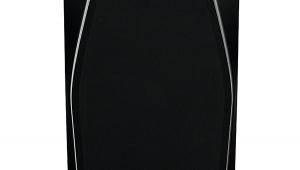Sonus Faber Toy (£745)
Whether it’s bravery, a weak grasp of colloquial English or a misguided belief that some wag won’t abuse the name, Sonus faber has anointed its smallest-ever two-way with the moniker ‘Toy Speaker’. Undoubtedly, as its literature proclaims, it chose that tag because it suggests joy: ‘Toys have always been synonymous with happiness and surprise.’ And – cynical rotters aside – the first reaction you’ll have when you see the new baby is not that the name contains an intrinsic insult, but that the product is, well, adorable.
Although deeper than an LS3/5a, it is narrower and shorter at 265x185x270mm (hwd). It’s also prettier, probably prettier than any tiny speaker I can name that purports to offer sound of true hi-fi quality. It is obviously a product from Sonus faber, and you’d know it even if you first saw it sans grille, where the name runs down the right-hand edge.
You tell me where the compromises were made: It has a sloped front baffle, curved edges, the same 25mm ring radiator tweeter with lethal centre piece found throughout the range, coming in at 4500Hz above a 110mm coated cellulose cone woofer. The back contains the port at the top, and a pair of superb multi-way terminals. Remove the grille, and there’s the signature Sonus faber antiqued metal badge, and the sides feature gilded bolt-heads.
Best of all, the Toy Speaker boasts a new finish, which may account for the manner in which they were able to price these at £745 per pair without sacrificing any sense of luxury. Instead of wooden sides, the Toy is finished in what they call ‘barred black leather’, a semi-matte finished hide that wouldn’t shame a well-cut jacket. I have no idea what ‘barred leather’ means, and Googling it took me to a gay S&M site, so let’s just say it looks terrific.
While suitable for shelf-mounting – probably the way most customers will take advantage of this diminutive speaker – I used them as I would LS3/5As, on 24in-tall stands. Like their dearer siblings, they benefit from a bit of toe-in. However, they were less in need of it than, say, Guarneri Homage or Auditor Ms. Wired with Yter cable to the McIntosh MC2102 power amp, the Toys betrayed their 87dB sensitivity: these do need a bit of power if you want them to fill a room greater than 4x5m.
A word about the grilles: because, as you’ll see, the speakers are seriously bass-light, they sound smoother and less peaky with the grilles in place. Treble response is not an issue with the Toy and the midband is of the
to-die-for variety, but they sound like what they are: small monitors.
UP AGAINST THE WALL
Which is not to say that they aren’t equally at home in a ‘bijou high-end’ context. If anything, you’ll need familiar material with crucially important bass content to flirt with anything that approaches dissatisfaction. My mistake, as it were, was to use as my first track the opener to the new Rory Block tribute to Son House, ‘Blues Walkin’ Like Man’, which features just her vocals and her bottleneck guitar work. Because there was no bass content to speak of, I just reeled back into my chair, thinking, ‘Holy cow! A rival for the LS3/5a!’
That was soon dispelled when I fed it some well-orchestrated Ella Fitzgerald circa 1962, The Times’ freebie of the Doors’ Strange Days and the soundtrack to The Sound of Music. Above a certain point, all was magic, with a gloriously wide and deep soundstage, extending well beyond the speakers’ outer edges. Vocals were both warm and natural, especially suiting the clarity of Ms Fitzgerald, and the textures of Jim Morrison. The electric keyboards on the Doors’ recordings were rich and suitably ringing, while the strings behind Ella bore the sheen that keeps me wedded to Sonus faber’s Cremona Auditor Elipsa.
But, and this is a huge ‘but’, the Toy simply doesn’t provide enough weight away from the walls to satisfy as a full-range speaker. Which reminded me of another small speaker designed not for stand mounting away from walls, but for shelf mounting that exploits the proximity of a rear wall: Wilson’s Duette.
Now I have gotten myself into a lot of trouble for swearing by them in stand-mount mode, but then they are considerably larger than the Toys. That aside, they were voiced for near-wall positioning, as – I suspect – were the Toys. Removed from their stands and sited near enough to the walls so as not to interfere with the rear port – about 150mm – the augmentation added just enough bass to fill in the region below to change one’s assessment.
I have no doubt that, like Wilson vendors, retailers selling Sonus fabers will soon learn to demonstrate them in shelf- or wall-mount mode.
QUESTION OF PERCEPTION
Curiously, there was no terrible side effect as regards the soundstage. Depending on whether or not they have clear space to the sides, the stage width and focus will be unaffected. If, though, they’re packed in-between books or CDs or LPs, a hint of congestion emerges. The tonal balance changed only in terms of perception: there was now a semblance of bass, the top-to-bottom balance improved, and some might even consider removing the grilles when the Toys sit on shelves.
Returning to the Rory Block recordings, clearly audible ‘body’ was added to the sound of the guitar, while scale remain unchanged. Both the orchestrated Ella and the Sound of Music soundtrack enjoyed greater room-filling properties. While the net effect hardly emulated the sudden arrival of a subwoofer, the Toy took on an entirely more satisfactory character.
Just for a laugh, I tried the Toys with a couple of subwoofers I happen to have, including a small Zingali and MartinLogan’s Descent. The transformation? I can only describe it as radical. Roll on, then, a dedicated powered Toy sub. They could call it the Toy Chest.
VERDICT
Sonus faber’s smallest speaker ever, the Toy is a solution for cramped flats and second systems, etc. It is not, however, a substitute for the Minima Vintage or Auditor M, both able to offer satisfying amounts of bass when on stands. If sited near walls, though, the Toy is, from 150Hz on up, classic Sonus faber, and a perfect match for the more powerful all-in-one mini-systems.

























































